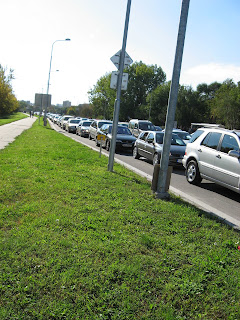 It is said that Andrew Carnegie, the nineteenth century Scottish industrialist and founder of Carnegie Steel Company, tallied the number of factory chimneys in Pittsburgh that were belching smoke as a leading indicator of the level of economic activity. If we were to use the number of cars traveling on the streets of Nitra today compared to 1996 as an indicator of Slovak economic growth, it would appear that there has indeed been significant economic growth in the Slovak Republic since 1996.
It is said that Andrew Carnegie, the nineteenth century Scottish industrialist and founder of Carnegie Steel Company, tallied the number of factory chimneys in Pittsburgh that were belching smoke as a leading indicator of the level of economic activity. If we were to use the number of cars traveling on the streets of Nitra today compared to 1996 as an indicator of Slovak economic growth, it would appear that there has indeed been significant economic growth in the Slovak Republic since 1996.Back in 1996 there were fewer cars on the streets of Nitra. And those were mostly the Communist era Skodas, Trabants, and Ladas. Today the cars on the streets of Nitra are mostly late model cars similar to the smaller cars found in Western Europe. Of course, there are fewer luxury cars here than in the West. 
Despite an excellent bus system in Nitra (population of 100,000), the traffic here seems a bit heavier than in Dover. And, the Slovaks are apparently not yet finished with their love affair with the car. More than 150,000 people attended the annual car show here in Nitra this past weekend.

Despite an excellent bus system in Nitra (population of 100,000), the traffic here seems a bit heavier than in Dover. And, the Slovaks are apparently not yet finished with their love affair with the car. More than 150,000 people attended the annual car show here in Nitra this past weekend.
Since I didn’t want to generalize too much from my limited personal observation, I attempted to find some data on the growth in automobile ownership in Slovakia since 1996. I was able to find from various data sources, including the Eurostat Yearbook and The World Bank that private car ownership in Slovakia increased from about 197 per 1000 population in 1996 to over 237 per 1000 population in 2003. In larger cities such as Nitra private car ownership today is estimated to be well over 300 per 1000 population. Of course, this is still significantly below the 750 autos per 1000 population in the United States, but it is certainly a noticeable increase since 1996.


Indeed, Slovakia has been experiencing rapid economic growth since 2000. According to data reported in The Economist and Slov Stat Online, real GDP increased at an average annual rate of 5.15 percent between 2001 and 2005. It increased by 6 percent in 2005 and by 8.3 percent in 2006. This year the country's real GDP is expected to increase by over 9 percent. This economic growth is primarily attributable to the market reforms initiated by the government of Prime Minister Mikulas Dzurinda. Dzurinda served as Prime Minister from 1998 to 2006.
Of course, all is not rosy. Despite the rapid economic growth that has occurred here, some have been left behind. There is a problem of structural unemployment and it is heavily concentrated within specific groups and regions of the country.
In future posts I hope to discuss some of the specific reforms instituted during the years of the Dzurinda government that provided the foundation for the rapid economic growth Slovakia is now experiencing.
No comments:
Post a Comment